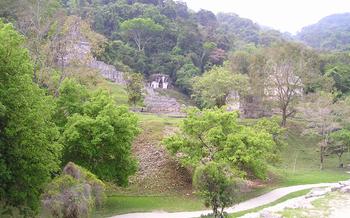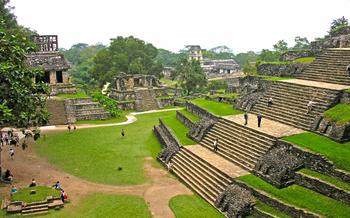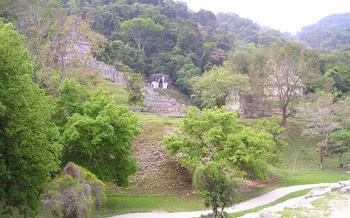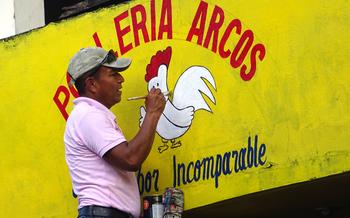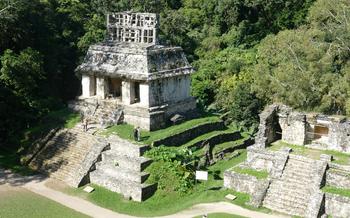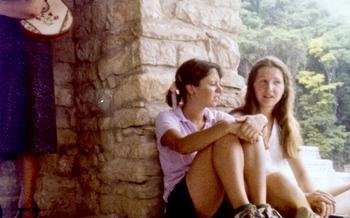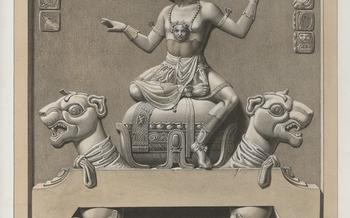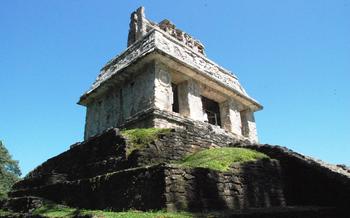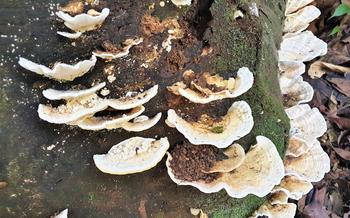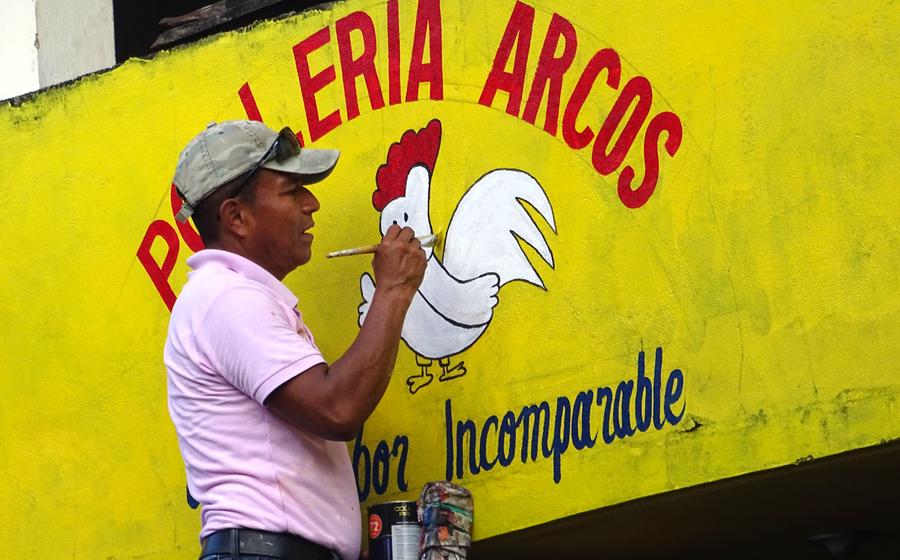
Sendero de la Selva
- The Mayan City of Palenque
- Sendero de la Selva (Jungle Trail)
- Planning Your Visit
- Getting to Palenque
- Exploring the Trail
- Uncovering the Secrets of the Jungle
- The Temple of Inscriptions
- The Palace
- The Great Plaza
- The Temple of the Sun
- The Temple of the Cross
- The Temple of the Foliated Cross
- The Aqueduct
- The Museum of Palenque
- Insider Tips
The Mayan City of Palenque
Palenque, nestled within the lush jungles of Chiapas, Mexico, stands as a testament to the ingenuity and artistry of the ancient Maya civilization. This once-thriving metropolis, dating back to the 7th century AD, played a pivotal role in the Maya world, serving as a political, economic, and cultural hub.
Palenque's unique allure lies in its exquisite architecture and intricate sculptures. The city's buildings, adorned with bas-reliefs depicting mythical creatures and scenes from Maya mythology, showcase the exceptional craftsmanship of its artisans. Among these architectural wonders are the Temple of Inscriptions, the Palace, and the Temple of the Sun, each possessing its own significance and captivating features.
Palenque's importance in the Maya civilization is further evidenced by its elaborate water management system, which included a network of canals, reservoirs, and aqueducts. These engineering marvels ensured a steady supply of water for the city's growing population and facilitated agricultural activities, contributing to Palenque's prosperity and influence.
Sendero de la Selva (Jungle Trail)
Nestled within the verdant embrace of the Palenque National Park, the Sendero de la Selva (Jungle Trail) beckons adventurers with its untamed beauty and rich biodiversity. This enchanting trail, spanning approximately 5 kilometers, offers an immersive experience through the heart of the Mayan jungle. Despite its moderate difficulty level, the trail rewards hikers with a plethora of natural wonders, making it a must-visit attraction for nature enthusiasts and adventure seekers alike.
Along the winding path, hikers are greeted by a symphony of sounds, from the raucous calls of exotic birds to the gentle whisper of the jungle breeze. The trail meanders through a diverse array of flora, showcasing towering trees, vibrant orchids, and ferns that unfurl like delicate tapestries. Amidst this verdant paradise, wildlife thrives, with monkeys swinging through the canopy, colorful birds flitting among the foliage, and reptiles basking in the dappled sunlight.
This captivating trail leads to hidden waterfalls, inviting hikers to take a refreshing dip in their cool waters. Intriguing caves, adorned with ancient rock formations, beckon explorers to delve into the mysteries they hold. The Sendero de la Selva is not just a trail; it's an invitation to connect with the untamed spirit of the jungle, to embrace the symphony of life that echoes through its depths, and to create memories that will last a lifetime.
Planning Your Visit
When planning your visit to Palenque and the Sendero de la Selva, it's crucial to consider the best time to visit, the entrance fees and permits required, and what to pack.
Best Time to Visit: - The dry season from November to May is ideal for visiting Palenque, as the weather is pleasant and the trails are less muddy. However, the city can be crowded during this time. - During the rainy season from June to October, the trails may be slippery, and some areas might be inaccessible due to flooding. However, the lush vegetation and fewer crowds can make it a unique experience.
Entrance Fees and Permits: - To enter the Palenque National Park, you'll need to pay an entrance fee. The fee varies depending on your nationality and the length of your stay. - For the Sendero de la Selva, you might need a permit from the park authorities. Check with the park office or your tour operator for specific requirements.
Packing Tips: - Wear comfortable hiking shoes or sneakers for the trail. - Bring insect repellent, sunscreen, and a hat to protect yourself from the sun and insects. - Pack a camera to capture the stunning scenery and wildlife. - Consider bringing a raincoat or poncho during the rainy season.
Getting to Palenque
Palenque is easily accessible from major cities in Mexico, such as Cancun, Mexico City, and Merida. The most convenient option is to fly into Palenque International Airport (PQM), which is located just 11 kilometers from the city center. Several airlines, including Aeromexico, Viva Aerobus, and Volaris, offer direct flights to Palenque from various destinations within Mexico.
For those traveling on a budget, long-distance buses provide an affordable alternative. There are direct bus routes to Palenque from Mexico City, Cancun, and San Cristobal de las Casas. The journey takes approximately 12 hours from Mexico City and 8 hours from Cancun. Buses arrive at the Palenque bus station, which is located about 2 kilometers from the city center.
Once in Palenque, local transportation options, such as taxis and colectivos (shared vans), are readily available. Taxis are a convenient but more expensive option, while colectivos are a cheaper and more local experience. Colectivos depart from the bus station and travel to various destinations within the city, including the entrance to the Palenque National Park.
Exploring the Trail
The Sendero de la Selva is a well-maintained trail that takes you through a diverse range of ecosystems, from lush rainforest to cascading waterfalls. The trail is relatively flat, making it accessible to hikers of all levels. Along the way, you'll encounter a variety of wildlife, including monkeys, birds, and reptiles. Keep your eyes peeled for the elusive jaguar, which is known to roam the area.
One of the highlights of the trail is the Agua Azul waterfall, a stunning cascade of turquoise water that plunges into a pool below. Take a refreshing dip in the cool waters of the waterfall before continuing on your hike. Another must-see is the Templo de la Calavera, a small temple adorned with intricate carvings.
The Sendero de la Selva is a great way to experience the natural beauty and cultural heritage of Palenque. Be sure to bring your camera and plenty of water, as there are no facilities along the trail.
Uncovering the Secrets of the Jungle
Venturing into the Sendero de la Selva is not just a hike through the wilderness; it's a journey into the heart of the Mayan jungle, a realm teeming with life and ancient secrets. The trail unveils a symphony of biodiversity, from towering trees to delicate orchids, each playing a vital role in the ecosystem. Discover the medicinal properties of plants that have been revered by local healers for generations. Keep your eyes peeled for wildlife encounters, from playful monkeys swinging through the canopy to vibrant birds flitting among the foliage. The jungle is alive with the sounds of nature, creating a captivating chorus that echoes through the forest. Embrace the opportunity to connect with the natural world and gain a deeper appreciation for the intricate tapestry of life that thrives within the Mayan jungle.
The Temple of Inscriptions
The Temple of Inscriptions is one of the most iconic and significant structures in Palenque. It was discovered in 1949 by Mexican archaeologist Alberto Ruz Lhuillier, who spent the next three years excavating the temple and uncovering its secrets. The temple is notable for its elaborate carvings and hieroglyphic inscriptions, which provide valuable insights into the history and culture of the Maya civilization.
One of the most important discoveries made at the Temple of Inscriptions was the tomb of Pacal the Great, one of the most powerful and influential rulers of Palenque. The tomb was found beneath the temple and contained a wealth of artifacts, including a massive stone sarcophagus with a beautifully carved lid depicting Pacal's journey to the afterlife. The discovery of the tomb and its contents has shed new light on the beliefs and practices of the ancient Maya.
Visitors to the Temple of Inscriptions can climb the steep steps to the top of the temple for stunning views of the surrounding jungle and the Great Plaza. Inside the temple, visitors can see the intricate carvings and hieroglyphs that adorn the walls, as well as the sarcophagus of Pacal the Great. The Temple of Inscriptions is a must-see for anyone visiting Palenque, as it offers a glimpse into the fascinating world of the ancient Maya.
The Palace
The Palace stands as a testament to the grandeur and artistry of the ancient Maya civilization. As the largest structure in Palenque, it served as the royal residence and administrative center during its heyday. Exploring the palace is like stepping back in time, immersing yourself in the lives and customs of the Maya elite.
Admire the intricate carvings and bas-reliefs adorning the palace's exterior, depicting scenes from Maya mythology, history, and everyday life. Each panel tells a story, offering a glimpse into the minds and beliefs of this ancient civilization.
Inside the palace, discover a labyrinth of rooms and chambers, each with its own unique purpose. Marvel at the well-preserved murals and paintings, which showcase the artistic prowess of the Maya and provide insights into their religious beliefs and rituals.
Unravel the mysteries surrounding the palace's function. Was it solely a royal residence, or did it serve other purposes, such as a temple or a center for political and economic activities? The answers to these questions are still debated among scholars, adding to the allure and mystique of this magnificent structure.
The Great Plaza
The Great Plaza, the heart of Palenque, served as the city's main gathering place and was used for both religious ceremonies and public events. This impressive open space is flanked by towering temples, pyramids, and palaces, creating a sense of awe and grandeur.
Strolling through the Great Plaza, visitors can marvel at the intricate carvings and bas-reliefs adorning the surrounding structures, depicting scenes from Mayan mythology, history, and everyday life. The acoustics of the plaza are also remarkable, with sounds echoing and reverberating, creating a unique and immersive experience.
One of the most striking features of the Great Plaza is the Temple of the Inscriptions, located at its northern end. This pyramid-shaped temple houses the tomb of Pacal the Great, one of the most powerful and influential rulers of Palenque. The temple's interior is adorned with exquisite carvings and hieroglyphs, providing valuable insights into the life and achievements of Pacal the Great.
Exploring the Great Plaza is a journey through time, allowing visitors to connect with the ancient Maya and immerse themselves in their rich culture and history.
The Temple of the Sun
Located on the east side of the Great Plaza, the Temple of the Sun is one of the most iconic structures in Palenque. Its unique architectural features, including a circular tower and a corbelled arch, set it apart from other temples in the city. The temple is dedicated to the Mayan sun god, Kinich Ahau, and is believed to have served as an astronomical observatory.
The circular tower of the temple is a distinctive feature that has led to speculation about its purpose. Some believe that it was used to track the movement of the sun and determine the solstices. Others suggest that it was a platform for religious ceremonies or a lookout tower for observing the surrounding area.
The interior of the temple is decorated with intricate carvings and bas-reliefs depicting scenes from Mayan mythology and history. These carvings provide valuable insights into the beliefs and practices of the ancient Mayans. Visitors can climb to the top of the temple for stunning views of the Great Plaza and the surrounding jungle.
The Temple of the Cross
Located on the east side of the Great Plaza, the Temple of the Cross is one of the most intriguing structures in Palenque. Its significance lies in the intricate iconography and symbolism that adorn its walls. The temple is named after the large cross-like symbol that dominates the interior, representing the sacred ceiba tree, a symbol of life and fertility in Mayan culture.
The temple's exterior is adorned with elaborate carvings depicting various gods, rulers, and mythological scenes. These carvings provide valuable insights into Mayan beliefs, history, and artistic traditions. The interior of the temple is equally impressive, featuring a series of chambers and passageways decorated with colorful murals and bas-reliefs.
Exploring the Temple of the Cross allows visitors to delve deeper into the religious and symbolic world of the ancient Mayans. It is a place where art, architecture, and spirituality converge, offering a glimpse into the complex cultural and intellectual landscape of this ancient civilization.
The Temple of the Foliated Cross
Nestled amidst the verdant foliage of the jungle, the Temple of the Foliated Cross stands as a testament to the intricate artistry and religious beliefs of the ancient Mayans. Located within the Palenque National Park, this temple holds a significant place in the history and culture of the Mayan civilization.
The temple derives its name from the intricate carvings adorning its facade, depicting a foliated cross—a symbol often associated with the Mayan creation myth and the Tree of Life. These intricate carvings showcase the exceptional craftsmanship and attention to detail that characterized Mayan art and architecture.
Inside the temple, visitors can explore a series of chambers and galleries, each adorned with unique carvings and bas-reliefs. These intricate depictions narrate stories from Mayan mythology, showcasing their beliefs, rituals, and the divine beings they worshipped.
As you delve deeper into the temple, you'll discover a sanctum sanctorum, where the ancient Mayans performed sacred rituals and ceremonies. This inner chamber is adorned with elaborate carvings and sculptures, creating an aura of reverence and mystery.
Exploring the Temple of the Foliated Cross is a journey into the spiritual realm of the ancient Mayans. Its intricate carvings, captivating iconography, and sacred chambers provide a glimpse into their complex belief system and the significance of this temple in their religious practices.
The Aqueduct
In the heart of the Palenque National Park, a testament to the ingenuity of the ancient Maya civilization stands tall: the Aqueduct. This remarkable structure, dating back to the 7th century, was meticulously engineered to transport water from a distant river to the city center, providing a vital lifeline for its inhabitants.
The aqueduct, a marvel of ancient engineering, stretched for several kilometers, traversing rugged terrain and natural obstacles. Constructed using limestone blocks, it showcased the Maya's mastery of hydraulics and construction techniques. The conduit, meticulously designed with a gentle slope, ensured a continuous flow of water into the city's reservoirs.
Exploring the aqueduct offers a glimpse into the advanced urban planning of the Maya. Its strategic placement, harnessing the force of gravity, demonstrates their understanding of water management and sustainable resource utilization. As you trace the path of the aqueduct, you'll encounter lush vegetation, cascading waterfalls, and hidden caves, making the journey an immersive experience into nature and history.
The Museum of Palenque
Enrich your understanding of Palenque's captivating past at the onsite museum. Located within the archaeological zone, this treasure trove of knowledge houses an impressive collection of artifacts, sculptures, and stelae that provide a glimpse into the city's rich history and culture.
Through interactive displays and informative exhibits, the museum narrates the story of Palenque's rise and fall, showcasing the artistry, engineering prowess, and religious beliefs of its ancient inhabitants. Marvel at intricate carvings, decipher hieroglyphs, and uncover the secrets of the Mayan civilization as you wander through the museum's halls.
Don't miss the opportunity to admire the iconic death mask of Pacal the Great, a masterpiece of Mayan craftsmanship that adorned the ruler's tomb in the Temple of Inscriptions. This exquisite mask, adorned with jade and turquoise, offers a glimpse into the grandeur and artistry of Palenque's royal court.
Insider Tips
-
Secret Spots for Photography: Venture off the beaten path to discover hidden gems for capturing stunning photographs. Look for secluded corners of the ruins, immerse yourself in the lush jungle, or climb to higher vantage points to capture panoramic views.
-
Local Restaurants for Authentic Mayan Cuisine: Indulge in the flavors of traditional Mayan cuisine at local restaurants. Ask locals for recommendations or explore the town's market to find fresh ingredients and local delicacies. Don't miss out on trying regional dishes like poc chuc (grilled pork), panuchos (fried tortillas with beans and meat), and salbutes (fried tortillas with turkey or chicken).
-
Tips for Avoiding Crowds: To escape the crowds and fully immerse yourself in the tranquility of Palenque, plan your visit during the shoulder season (May-June and September-October). Arrive early in the morning or late in the afternoon to avoid the peak tourist hours. Additionally, consider exploring the lesser-known ruins and trails, such as the Temple of the Cross or the Otulum Cascade, to find moments of solitude and serenity.
